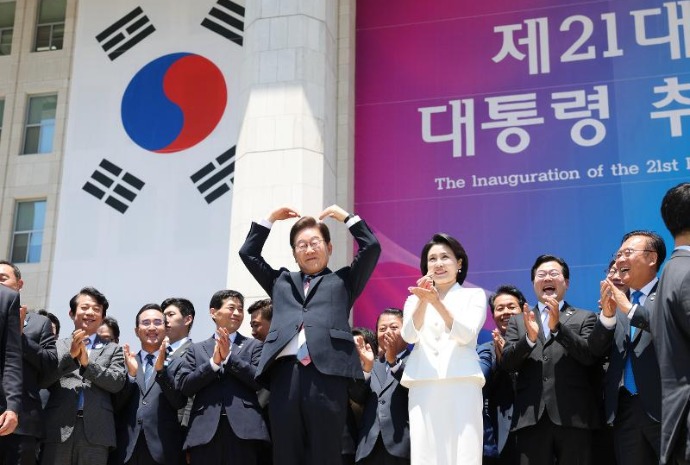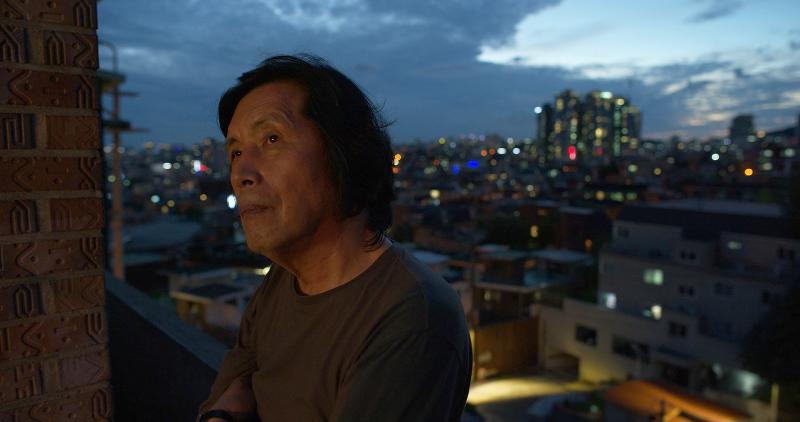
This scene from the documentary "Lee Chang-dong: the Art of Irony," which was screened in May at the World Premiere section of the Jeonju International Film Festival, shows the eponymous director. (Jeonju International Film Festival)
By Jung Joo-ri
What do people do when impressed by a work of art? The myriad ways include taking a photo or writing or talking about it.
French director Alain Mazars chose to honor his favorite works by making a documentary. He saw and was entranced by the films of Korean director Lee Chang-dong about 20 years ago in France. To convey the touching emotions he felt from such films, Mazars made feature-length documentary "Lee Chang-dong: The Art of Irony," which was released this year.
Born in 1955 in Paris, Mazars has made over 20 films and documentaries. He made a name for himself through his documentaries on movie directors such as Douglas Sirk, Jacques Tourneur and Atom Egoyan.
His movie on Lee sheds light on the art world of the eponymous director who represents auteur theory, a way of looking at art that has an artist's characteristics and personal touch reflected in his or her works. Born in 1954 in Daegu, Lee was a Korean-language teacher and later a poet. In his 40s, he made his directorial debut with "Green Fish" (1997) and received the Blue Dragon Award at the 16th Vancouver International Film Festival, an honor given to a new Asian director.
"Oasis" (2002) earned him the Silver Lion for Best Director at the 59th Venice Film Festival. Other works like "Secret Sunshine" (2007), "Poetry" (2010) and "Burning" (2018) were invited to the competition section of the Cannes Film Festival. In 2010, his "Poetry" clinched the won the best screenplay award at the festival.
The documentary on Lee attracted major attention while shown in the World Premiere section of the 23rd Jeonju International Film Festival in Korea (April 28 to May 7). The film was also shown at the 19th EBS International Documentary Festival (Aug. 22-28) and received an invitation to the Lumiere Festival in Lyon, France (Oct. 15-23).
Mazars, who lives in Paris and is working on his next film based in Myanmar, gave a written interview to Korea.net, excerpts from which are below.
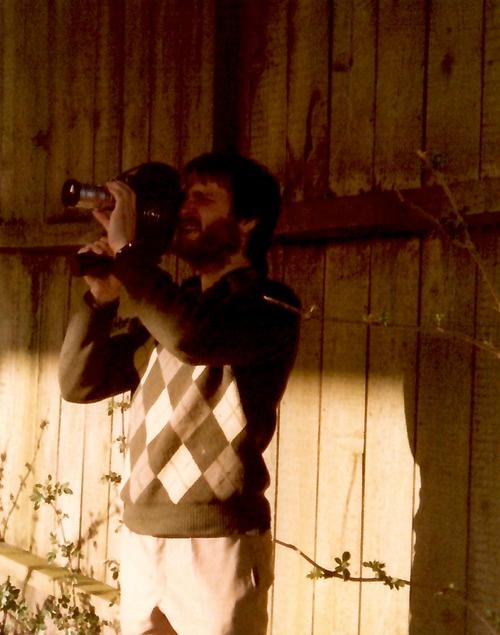
Documentary director Alain Mazars
How did a Frenchman end up making a documentary about a Korean director?
The first film I saw made by Lee was "Peppermint Candy" (2000), when the film -- his second -- was nominated for the Director's Fortnight at the 53rd Cannes Film Festival. I was deeply moved by the (movie's) bold structure of going back in time. It was my first time being shocked by a film. I later saw Lee's third film "Oasis," which was distributed by N.T. Binh, a film critic at the French film magazine Positif. The brilliant subject matter, outstanding script, strength of the mise-en-scene and enthusiastic acting by the cast -- everything truly made it a masterpiece.
After that, I watched other films by Lee such as "Secret Sunshine," "Poetry," "Burning" and his debut film "Green Fish," and these spurred me to make a documentary about the director. "Green Fish" was never officially released in France, but he skillfully conveyed his personal story in the genre film.
Describe the process of making the documentary.
I was inspired by Binh's written interview with Lee and thoroughly worked on the script. Thanks to Binh, I could contact Lee and get him to agree to appear in the documentary. I cooperated with Pinehouse Film, which produced Lee's movies; Movie Da, a production company that specializes in film documentaries; and producer Jean Fabrice Barnault and his team.
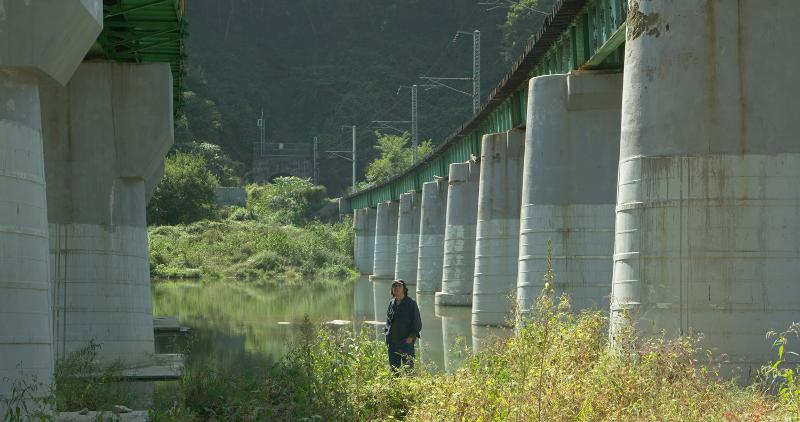
This scene from the documentary "Lee Chang-dong: The Art of Irony" show the site where the director's second work "Peppermint Candy" (2000) was filmed. (Jeonju International Film Festival)
The documentary shows places in Korea such as the Huam-dong neighborhood of Seoul's Yongsan-gu District; Paju, Gyeonggi-do Province; Ilsan-gu District in Goyang, Gyeonggi-do, or the backdrop of Lee's film "Green Fish"; and Seoul's Yeongdeungpo-gu District. How was filming?
If things went according to plan, we were to go to Seoul in March 2020 to film, but we unfortunately couldn't due to the COVID-19 pandemic. In such circumstances, the only way we could direct the film was through Zoom. I was in utter despair. It was my goal to meet this great artist and film director and visit Korea to directly see the places that I'd seen in his movies. For me, this was a crucial mission. I had such a deep admiration for director Lee so I couldn't give up filming this documentary. So in the end, I had to direct it online. Despite the physical distance, we could easily communicate with director Lee and others featured in the documentary thanks to excellent equipment and interpreter Cho Kyoung-hee. The filming took a combined 16 days last year from September to October.
Your documentary covers director Lee's movies in reverse chronological order, starting with his latest film "Heartbeat" and later his debut work "Green Fish" then to his childhood. Why did you decide on this sequence?
Since I began working on the script, I thought that I should cover the plot in reverse chronological order. I recalled how the structure of going back in time naturally flowed in Lee's film "Peppermint Candy," which was his first film that I saw. I wanted to let him visit the places where he filmed his movies, go back in time and recall his past life, and I wanted to join him as he recalled moments from his childhood, which is probably the source of his artistic inspiration.
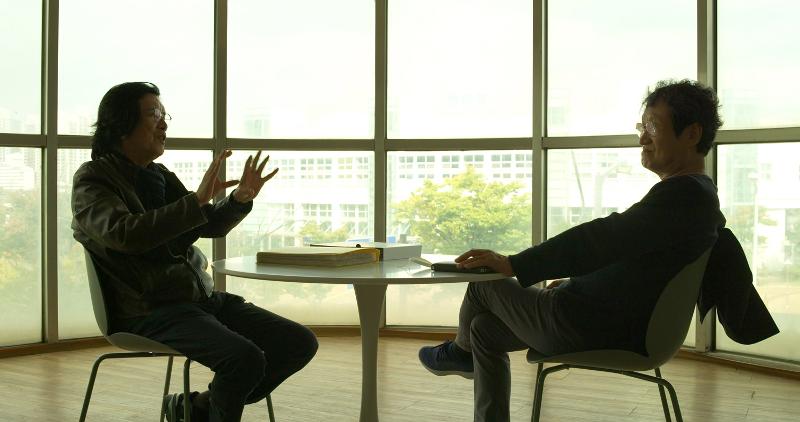
In this scene from the documentary "Lee Chang-dong: The Art of Irony" (2022), the director talks to actor Moon Sung-keun about the film "Green Fish." (Jeonju International Film Festival)
To understand Lee's life requires an understanding of modern Korean history. This must have been a bit difficult for you as a non-Korean.
Through this documentary, I wanted to draw a portrait of an artist I admire. I also wanted to show a connection between Korean history and his life. When I began writing the script, I knew almost nothing about modern Korean history. Thanks to director Lee, writer Oh Jung-mi and the staff, I learned during filming and later while editing historical facts such as the May 18 Gwangju Democratization Movement, which served as the inspiration for "Peppermint Candy" and several novels.
What moment or place do you remember most while filming?
When it's daytime in Korea, it's night in France, so while filming, I felt like I was daydreaming. All the places I filmed were memorable and left deep impressions on me. The place I remember the most is a riverside in Miryang, Gyeongsangnam-do Province. The scenery there was similar to that of a region in China adjoining the North Korean border. I lived and worked there for a year in 1978 as a teaching assistant.
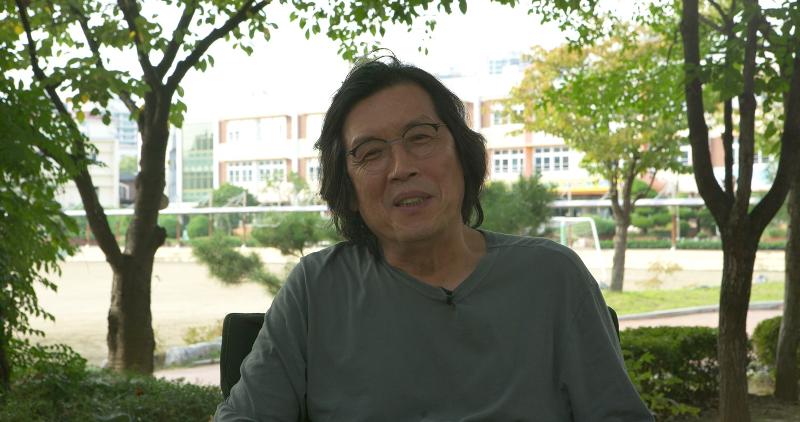
In the documentary "Lee Chang-dong: The Art of Irony," the director visits his elementary school and recalls his childhood. (Jeonju International Film Festival)
Why do you define director Lee's works as the "art of irony?"
The "art of irony" is a theme that I thought of from when I worked on the script. The documentary travels through time and space and asks questions about characters in each of director Lee's films. The "dramatic irony" that he discusses is aimed at his films' characters. Each character has an irony of destiny. I wanted to answer through this documentary questions such as what logic the characters follow, how the social, environmental and historical contexts affect them, how the cast who portray such characters are, how the director makes characters out of the cast and portrays them on camera, whether the characters are not the main ones who reflect the director's humanity and worldview, and how the director and his characters are related.
What would you like to tell Korea.net readers who will watch your documentary?
The first goal of this documentary is to stimulate the desire of cinema lovers who have long wanted to watch director Lee's films. If a Western viewer like me from a place far from Korea loves his films enough to make a documentary about him, this means that his works are universal and relatable. To someone who has never watched a movie by the director, I recommend watching all of his movies. Through this documentary, you can watch his works on a movie screen.
etoilejr@korea.kr
